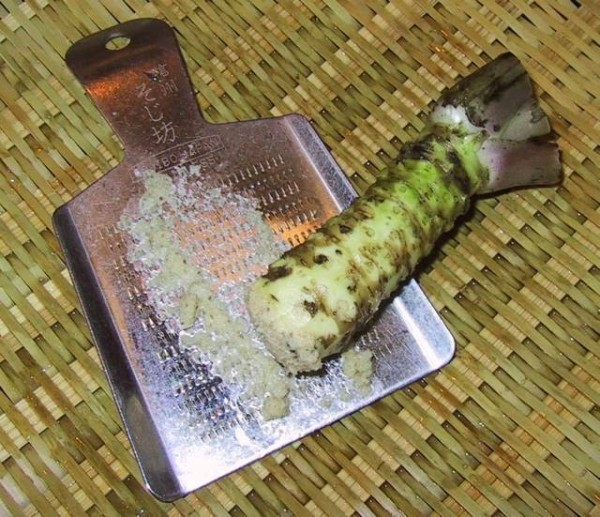New Study Reveals Why Wasabi Makes Us Wince
| Marco Foronda | | Apr 09, 2015 08:59 AM EDT |
(Photo : wikipedia.org) Wasabi on a metal oroshigane grater
Researchers at University of California San Francisco uncovered the structure of the protein behind the burning sensation that occurs when people eat sushi with wasabi, a discovery that could improve future pain medications.
The protein (TRPA1) is found in sensory nerve cells and it's what causes you to cry, wince or scratch in response to wasabi. TRPAI also causes the same reactions to mustard, garlic, tear gas, bacterial infections, itchy irritants and possibly very, very cold weather.
Like Us on Facebook
It might even be involved in hearing. Scientists at UCSF have revealed the 3D images of it on a molecular level.
For years, scientists have tried to determine the structure of TRPA1 to design more effective pain relief but the imaging wasn't sophisticated enough. Researchers used a new imaging technology called electron cryo-microscopy to image the protein at a resolution of four angstroms. By comparison, a sheet of paper is about 1 million angstroms thick.
"The pain system is there to warn us when we need to avoid things that can cause injury, but also to enhance protective mechanisms", said David Julius, professor and chair of UCSF's Department of Physiology, and co-senior author of the new study.
"We've known that TRPA1 is very important in sensing environmental irritants, inflammatory pain and itch, and so knowing more about how TRPA1 works is important for understanding basic pain mechanisms. Of course, this information may also help guide the design of new analgesic drugs,"
Proteins were placed in an aqueous solution then frozen in a very thin sheet of ice so quickly the water didn't have time to form crystals. It's critical the ice remains in a glassy state because formation of any ice crystals will damage proteins embedded within ice and interfere with determining the structure of the proteins in their native conformation.
With many copies of the proteins suspended in this glassy ice, the researchers captured as many as 100,000 images and computationally combined these thousands of two-dimensional views to generate the three-dimensional structure of the protein.
They show TRPA1 in three different states-closed, open, and partially open-a range that offers a lot of insight into the channel's workings. Scientists expect to generate additional structures in more distinct conformations in future research.
The drugs targeting TRPA1 could also be used to block out chronic itch associated with eczema and some nerve disorders.
TagsNew Study Reveals Why Wasabi Makes Us Wince, wasabi, Wasabi Receptor, wasabi new pain meds, TRPA1, Protein
©2015 Chinatopix All rights reserved. Do not reproduce without permission
EDITOR'S PICKS
-

Did the Trump administration just announce plans for a trade war with ‘hostile’ China and Russia?
-

US Senate passes Taiwan travel bill slammed by China
-

As Yan Sihong’s family grieves, here are other Chinese students who went missing abroad. Some have never been found
-

Beijing blasts Western critics who ‘smear China’ with the term sharp power
-

China Envoy Seeks to Defuse Tensions With U.S. as a Trade War Brews
-

Singapore's Deputy PM Provides Bitcoin Vote of Confidence Amid China's Blanket Bans
-

China warns investors over risks in overseas virtual currency trading
-

Chinese government most trustworthy: survey
-

Kashima Antlers On Course For Back-To-Back Titles
MOST POPULAR
LATEST NEWS
Zhou Yongkang: China's Former Security Chief Sentenced to Life in Prison

China's former Chief of the Ministry of Public Security, Zhou Yongkang, has been given a life sentence after he was found guilty of abusing his office, bribery and deliberately ... Full Article
TRENDING STORY

China Pork Prices Expected to Stabilize As The Supplies Recover

Elephone P9000 Smartphone is now on Sale on Amazon India

There's a Big Chance Cliffhangers Won't Still Be Resolved When Grey's Anatomy Season 13 Returns

Supreme Court Ruled on Samsung vs Apple Dispute for Patent Infringement

Microsoft Surface Pro 5 Rumors and Release Date: What is the Latest?










